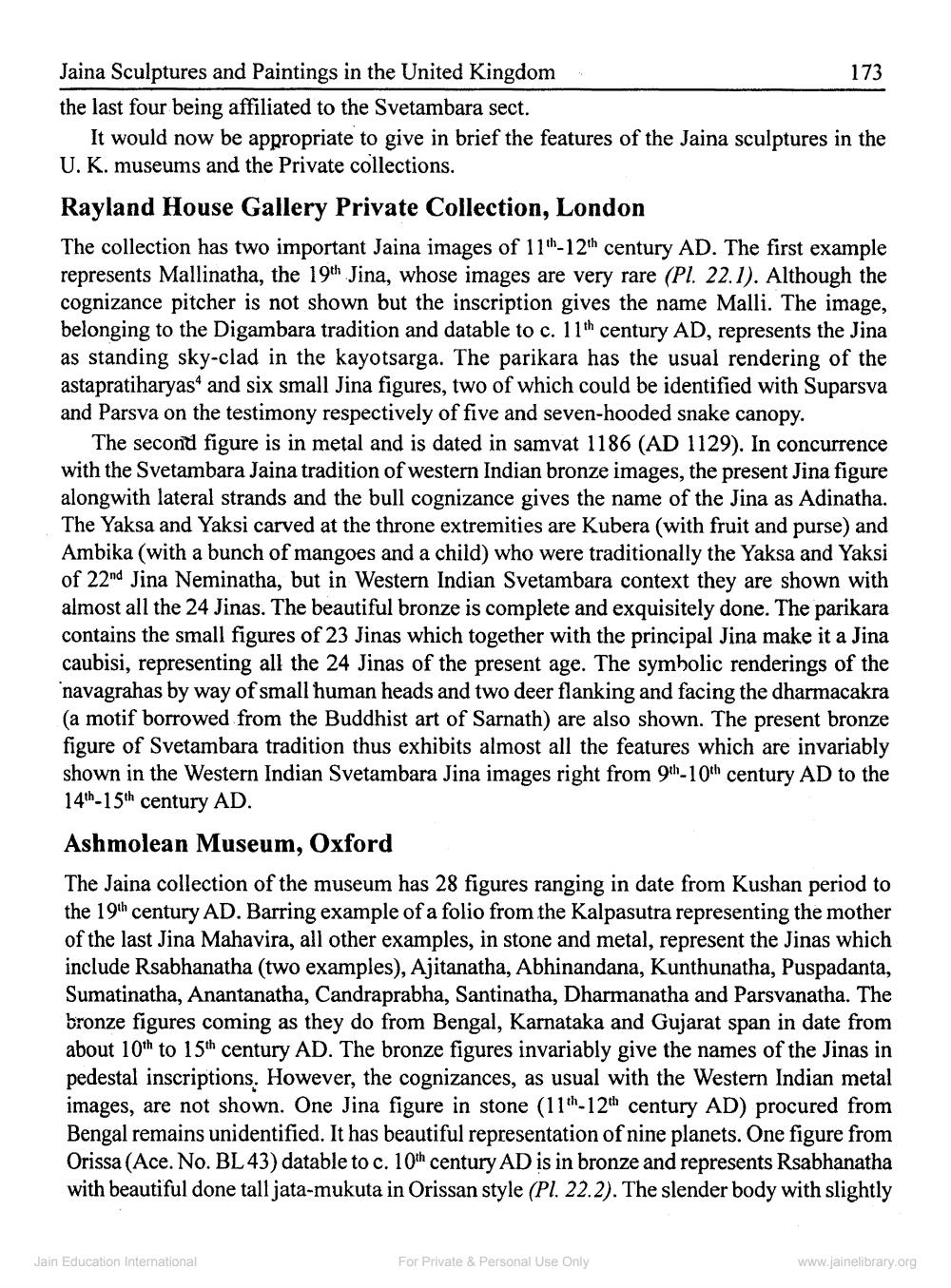________________
173
Jaina Sculptures and Paintings in the United Kingdom the last four being affiliated to the Svetambara sect.
It would now be appropriate to give in brief the features of the Jaina sculptures in the U. K. museums and the Private collections. Rayland House Gallery Private Collection, London The collection has two important Jaina images of 11th 12th century AD. The first example represents Mallinatha, the 19th Jina, whose images are very rare (Pl. 22.1). Although the cognizance pitcher is not shown but the inscription gives the name Malli. The image, belonging to the Digambara tradition and datable to c. 11th century AD, represents the Jina as standing sky-clad in the kayotsarga. The parikara has the usual rendering of the astapratiharyas and six small Jina figures, two of which could be identified with Suparsva and Parsva on the testimony respectively of five and seven-hooded snake canopy.
The second figure is in metal and is dated in samvat 1186 (AD 1129). In concurrence with the Svetambara Jaina tradition of western Indian bronze images, the present Jina figure alongwith lateral strands and the bull cognizance gives the name of the Jina as Adinatha. The Yaksa and Yaksi carved at the throne extremities are Kubera (with fruit and purse) and Ambika (with a bunch of mangoes and a child) who were traditionally the Yaksa and Yaksi of 22nd Jina Neminatha, but in Western Indian Svetambara context they are shown with almost all the 24 Jinas. The beautiful bronze is complete and exquisitely done. The parikara contains the small figures of 23 Jinas which together with the principal Jina make it a Jina caubisi, representing all the 24 Jinas of the present age. The symbolic renderings of the 'navagrahas by way of small human heads and two deer flanking and facing the dharmacakra (a motif borrowed from the Buddhist art of Sarnath) are also shown. The present bronze figure of Svetambara tradition thus exhibits almost all the features which are invariably shown in the Western Indian Svetambara Jina images right from 9th-10th century AD to the 14th-15th century AD.
Ashmolean Museum, Oxford The Jaina collection of the museum has 28 figures ranging in date from Kushan period to the 19th century AD. Barring example of a folio from the Kalpasutra representing the mother of the last Jina Mahavira, all other examples, in stone and metal, represent the Jinas which include Rsabhanatha (two examples), Ajitanatha, Abhinandana, Kunthunatha, Puspadanta, Sumatinatha, Anantanatha, Candraprabha, Santinatha, Dharmanatha and Parsvanatha. The bronze figures coming as they do from Bengal, Karnataka and Gujarat span in date from about 10th to 15th century AD. The bronze figures invariably give the names of the Jinas in pedestal inscriptions. However, the cognizances, as usual with the Western Indian metal images, are not shown. One Jina figure in stone (11th 12th century AD) procured from Bengal remains unidentified. It has beautiful representation of nine planets. One figure from Orissa (Ace. No. BL 43) datable to c. 10th century AD is in bronze and represents Rsabhanatha with beautiful done tall jata-mukuta in Orissan style (Pl. 22.2). The slender body with slightly
Jain Education International
For Private & Personal Use Only
www.jainelibrary.org




